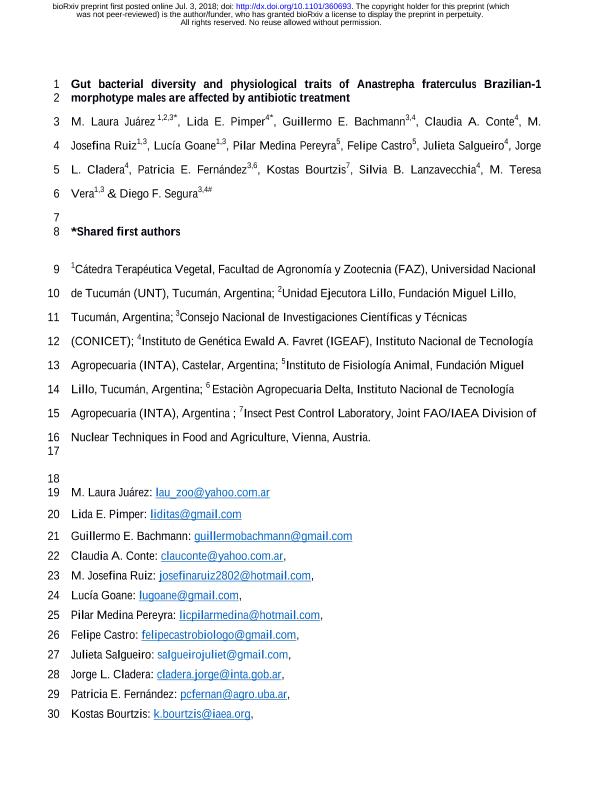Mostrar el registro sencillo del ítem
dc.contributor.author
Juárez, María Laura

dc.contributor.author
Pimper, Lida Elena

dc.contributor.author
Bachmann, Guillermo Enrique

dc.contributor.author
Conte, Claudia Alejandra

dc.contributor.author
Ruiz, María Josefina

dc.contributor.author
Goane, Lucía

dc.contributor.author
Medina Pereyra, Pilar
dc.contributor.author
Castro, Felipe
dc.contributor.author
Salgueiro, Julieta

dc.contributor.author
Caldera, Jorge Luis
dc.contributor.author
Fernández, Patricia Elena

dc.contributor.author
Bourtzis, Kostas
dc.contributor.author
Lanzavecchia, Silvia Beatriz

dc.contributor.author
Vera, María Teresa

dc.contributor.author
Segura, Diego Fernando

dc.date.available
2019-10-23T16:06:04Z
dc.date.issued
2018-07
dc.identifier.citation
Juárez, María Laura; Pimper, Lida Elena; Bachmann, Guillermo Enrique; Conte, Claudia Alejandra; Ruiz, María Josefina; et al.; Gut bacterial diversity and physiological traits of Anastrepha fraterculus Brazilian-1 morphotype males are affected by antibiotic treatment.; BioMed Central; BMC Microbiology; 7-2018; 1-55
dc.identifier.issn
1471-2180
dc.identifier.uri
http://hdl.handle.net/11336/87086
dc.description.abstract
Background: The interaction between gut bacterial symbionts and Tephritidae became the focus of several studies that showed that bacteria contributed to the nutritional status and the reproductive potential of its fruit fly hosts. Anastrepha fraterculus is an economically important fruit pest in South America. This pest is currently controlled by insecticides, which prompt the development of environmentally friendly methods such as the sterile insect technique (SIT). For SIT to be effective, a deep understanding of the biology and sexual behavior of the target species is needed. Although many studies have contributed in this direction, little is known about the composition and role of A. fraterculus symbiotic bacteria. In this study we tested the hypothesis that gut bacteria contribute to nutritional status and reproductive success of A. fraterculus males.Methods: Wild and laboratory-reared males were treated with antibiotics (AB) and provided sugar (S) or sugar plus protein (S+P) as food sources. The effect of AB on the gut bacteria diversity was assessed through DGGE and sequencing of the V6-V9 variable region of the bacterial 16S rRNA gene.Results: AB affected the bacterial community of the digestive tract of A. fraterculus, in particular59 bacteria belonging to the Enterobacteriaceae family, which was the dominant bacterial group in the control flies (i.e., non-treated with AB). AB negatively affected parameters directly related to the mating success of laboratory males and their nutritional status. AB also affected males?survival under starvation conditions. The effect of AB on the behaviour and nutritional status of the males depended on two additional factors: the origin of the males and the presence of a proteinaceous source in the diet.Conclusions: our results suggest that A. fraterculus 65 males gut contain symbiotic organisms that are able to exert a positive contribution on A. fraterculus males? fitness, although the physiological mechanisms still need further studies.
dc.format
application/pdf
dc.language.iso
eng
dc.publisher
BioMed Central

dc.rights
info:eu-repo/semantics/openAccess
dc.rights.uri
https://creativecommons.org/licenses/by-nc-sa/2.5/ar/
dc.subject
SOUTH AMERICAN FRUIT FLY
dc.subject
SYMBIONT
dc.subject
ANTIBIOTICS
dc.subject
NUTRITIONAL RESERVES
dc.subject
SURVIVAL
dc.subject
STERILE INSECT TECHNIQUE
dc.subject.classification
Otros Tópicos Biológicos

dc.subject.classification
Ciencias Biológicas

dc.subject.classification
CIENCIAS NATURALES Y EXACTAS

dc.title
Gut bacterial diversity and physiological traits of Anastrepha fraterculus Brazilian-1 morphotype males are affected by antibiotic treatment.
dc.type
info:eu-repo/semantics/article
dc.type
info:ar-repo/semantics/artículo
dc.type
info:eu-repo/semantics/publishedVersion
dc.date.updated
2019-10-22T17:32:26Z
dc.journal.pagination
1-55
dc.journal.pais
Reino Unido

dc.journal.ciudad
Londres
dc.description.fil
Fil: Juárez, María Laura. Universidad Nacional de Tucumán. Facultad de Agronomía y Zootecnia. Cátedra Terapéutica Vegetal; Argentina. Consejo Nacional de Investigaciones Científicas y Técnicas. Centro Científico Tecnológico Conicet - Tucumán; Argentina
dc.description.fil
Fil: Pimper, Lida Elena. Universidad de Buenos Aires. Facultad de Ciencias Exactas y Naturales. Departamento de Ecología, Genética y Evolución. Laboratorio de Genética de la Estructura Poblacional; Argentina
dc.description.fil
Fil: Bachmann, Guillermo Enrique. Instituto Nacional de Tecnología Agropecuaria. Centro de Investigación en Ciencias Veterinarias y Agronómicas. Instituto de Genética; Argentina
dc.description.fil
Fil: Conte, Claudia Alejandra. Consejo Nacional de Investigaciones Científicas y Técnicas. Centro Científico Tecnológico Conicet - Tucumán; Argentina
dc.description.fil
Fil: Ruiz, María Josefina. Consejo Nacional de Investigaciones Científicas y Técnicas. Centro Científico Tecnológico Conicet - Tucumán; Argentina
dc.description.fil
Fil: Goane, Lucía. Consejo Nacional de Investigaciones Científicas y Técnicas. Centro Científico Tecnológico Conicet - Tucumán; Argentina
dc.description.fil
Fil: Medina Pereyra, Pilar. Universidad Nacional de Tucumán. Facultad de Ciencias Naturales e Instituto Miguel Lillo; Argentina
dc.description.fil
Fil: Castro, Felipe. Fundación Miguel Lillo; Argentina
dc.description.fil
Fil: Salgueiro, Julieta. Instituto Nacional de Tecnología Agropecuaria. Centro de Investigación en Ciencias Veterinarias y Agronómicas. Instituto de Genética; Argentina. Consejo Nacional de Investigaciones Científicas y Técnicas. Centro Científico Tecnológico Conicet - Tucumán; Argentina
dc.description.fil
Fil: Caldera, Jorge Luis. Instituto Nacional de Tecnología Agropecuaria. Centro de Investigación en Ciencias Veterinarias y Agronómicas. Instituto de Genética; Argentina
dc.description.fil
Fil: Fernández, Patricia Elena. Instituto Nacional de Tecnología Agropecuaria. Centro Regional Buenos Aires Norte. Estación Experimental Agropecuaria Delta del Paraná; Argentina
dc.description.fil
Fil: Bourtzis, Kostas. Insect Pest Control Laboratory; Austria
dc.description.fil
Fil: Lanzavecchia, Silvia Beatriz. Instituto Nacional de Tecnología Agropecuaria. Centro de Investigación en Ciencias Veterinarias y Agronómicas. Instituto de Genética; Argentina. Consejo Nacional de Investigaciones Científicas y Técnicas. Centro Científico Tecnológico Conicet - Tucumán; Argentina
dc.description.fil
Fil: Vera, María Teresa. Universidad Nacional de Tucumán. Facultad de Agronomía y Zootecnia; Argentina. Consejo Nacional de Investigaciones Científicas y Técnicas. Centro Científico Tecnológico Conicet - Tucumán; Argentina
dc.description.fil
Fil: Segura, Diego Fernando. Instituto Nacional de Tecnología Agropecuaria. Centro de Investigación en Ciencias Veterinarias y Agronómicas. Instituto de Genética; Argentina. Consejo Nacional de Investigaciones Científicas y Técnicas. Centro Científico Tecnológico Conicet - Tucumán; Argentina
dc.journal.title
BMC Microbiology

dc.relation.alternativeid
info:eu-repo/semantics/altIdentifier/doi/https://dx.doi.org/10.1101/360693
dc.relation.alternativeid
info:eu-repo/semantics/altIdentifier/url/https://www.biorxiv.org/content/10.1101/360693v1
Archivos asociados
